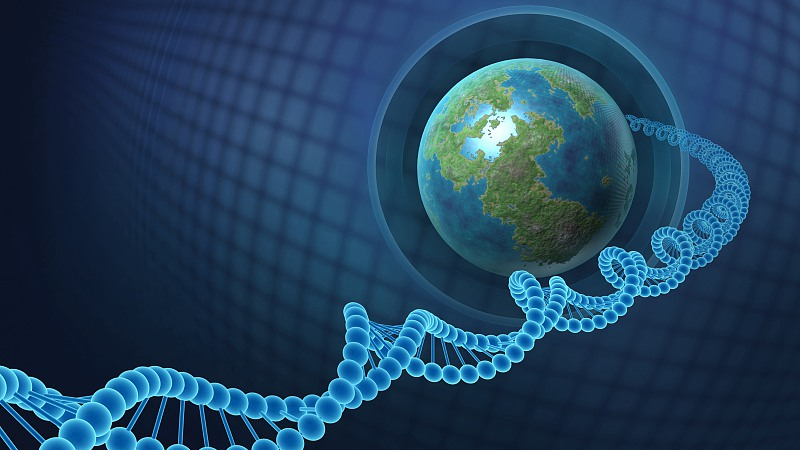A new article in Medical Anthropology Quarterly discusses the implications that the environmental degradation characteristic of the Anthropocene has for epigenetics and the human psyche. The article is written by medical anthropologist Margaret Lock of McGill University.
Lock discusses research and new theoretical perspectives that challenge genetic determinism, which insists that people are predetermined and bound by their genetic heritage. She goes on to explain the link between environmental factors, such as exposure to toxins and long-term deprivation, and genetic changes. Lock insists that the destruction of the environment in this geological era disproportionately affects the poor and the powerless, influencing genetic structures and causing several physical and mental health disorders.
 Genetic research has gained significant popularity in the last few decades, as seen in the rise of direct-to-consumer genetic tests. This is true even though many of these tests are often inaccurate. Genetic testing regularly promises significant breakthroughs that are assumed to be just around the corner.
Genetic research has gained significant popularity in the last few decades, as seen in the rise of direct-to-consumer genetic tests. This is true even though many of these tests are often inaccurate. Genetic testing regularly promises significant breakthroughs that are assumed to be just around the corner.
Genetic research has become popular in psychiatry and the mental health field, with some claiming that mental disorders have genetic causes and that finding the implicated gene will ensure full treatment. For example, a large body of research has been compiled on the search for the genetic underpinning of “schizophrenia.” However, most researchers now concede that schizophrenia is a polygenic disorder and that no single gene, or even a definite group of genes, will be identified as the cause of the disorder. Even when combined, most genetic models only contribute a small amount to the understanding of “schizophrenia.” Others contend that abuse and trauma, rather than genetic anomalies, lead to psychosis.
In this article, Lock describes the new geological era of the Anthropocene, which many experts say began in September 2016. The Anthropocene is a geological era marked primarily by human-made ecological degradation and humans’ awareness of their role in such degradation. Earlier researchers have written about the relationship between climate change, environmental degradation, grief, and disorders such as PTSD, depression, and even suicide.
Along with this shift, another change has occurred in our understanding of the function of the human genome. The human genome was thought to be inert and to determine all of our attributes (physical and mental) – a static blueprint of who we were destined to be.
Now we know that the human genome is “reactive” to the environment. In other words, the human genome is unstable and open to restructuring based on one’s experience and environment.
Lock insists that the planet is irreversibly transformed due to human actions, leading to long-standing changes in the environmental landscape. Additionally, the human genome is built to respond to the environment, and many of these environmental changes in the Anthropocene era are toxic, producing lasting influences on our genetic structure and our mental health. She writes:
“…environmental stimuli and stressors originating both externally and internally to the body initiate trains of molecular activity that modify how DNA functions during the course of individual development, at times with life-long effects on human behavior and well-being.”
Lock notes that much research on the effects of environmental violence on genetic changes focuses too narrowly on individual families. This form of research often blames poor mothers for causing permanent and adverse brain alterations in their babies.
While a lot of research on “biological embeddedness” has noticed the influence of childhood deprivation and maltreatment on people and its long-term neurological effects through epigenetic changes, Lock asserts that it would be faulty to blame individual families for this. Other researchers have echoed this sentiment, insisting that response to eco-anxiety needs to be more than a matter of personal life changes and instead geared toward collective action.
Lock suggests a shift in focus towards the role of systemic causes and structural determinants such as poverty, racism, colonization, political violence, etc. It is this environment that the genome is reactive to, not merely the failings of poor mothers.
Another complication of the Anthropocene era is described by the “mismatch hypothesis,” which suggests that if an organism has evolved in anticipation of certain adverse conditions and those conditions are not met, there can be a mismatch that is maladaptive for the organism.
For example, children of malnourished mothers who are born “anticipating” scarcity of food might suffer from marasmus, which includes having low birth weight. These children survive better than those who suffer from kwashiorkor and are not underweight as they “can endure greater wasting of flesh.” Thus, children with marasmus biologically anticipate adversity in utero and are more prepared for it. Given that large-scale global displacements are the mark of this geological era (refugee crisis, rising sea levels, droughts), more and more dangerous mismatches are expected.
Lock gives examples of some of the toxic and sudden human-made changes that have marked the Anthropocene, including exposure to pollutants such as lead and DDT. People who suffer most because of these toxins, which can cause brain atrophy and influence a child’s gene expression, are usually the poor and people of color, as seen in the crisis in Flint, Michigan.
Another pollutant is mercury which, when dumped in the water, causes numerous ill-effects such as tremors, loss of muscle coordination, suicide, hearing loss, etc. Its effects have been documented in Grassy Narrow’s Wabigoon River system in Ontario, Canada, and in the 1950s in Japan.
Apart from the poor, another group of people most affected by these drastic human-made environmental changes is, broadly characterized, “the colonized.” Not only are these groups vulnerable to toxic environments, but they also have a history of intergenerational historical trauma. Given the reactivity of the human genome to toxic environmental shifts, these populations are the worst affected.
Lock gives the example of the First Nations in Canada. Here even the breast milk of Inuit mothers has been found to contain the toxins (plastic, dioxin, PCBs) that reach the Arctic and are consumed by seals, whales, and fish, which are then consumed by people. Other forms of violence, such as loss of land, infectious diseases, loss of language and culture (through residential schools), high rates of sexual abuse and violence, etc. point to historical trauma inflicted on the colonized. Lock writes:
“It is not known if inter-generational transmission of DNA modifications has contributed to this situation. But it is likely that at the very least such modifications are re-created anew in each generation, given the extent of the involved trauma and toxicity.”
In conclusion, now that we know the human genome to be reactive to the environment, we must understand that context plays a biological role in trauma and other forms of mental suffering.
****
Lock, M. (2020). Toxic Environments and the Embedded Psyche. Medical Anthropology Quarterly. Published online first: April 20, 2020. (Link)















“now that we know the human genome to be reactive to the environment, we must understand that context plays a biological role in trauma and other forms of mental suffering.”
It’s truly a shame the “mental health” workers didn’t learn from their mistakes during the eugenics period, thus are now just learning that both nature and nurture are relevant.
“However, most researchers now concede that schizophrenia is a polygenic disorder and that no single gene, or even a definite group of genes, will be identified as the cause of the disorder. Even when combined, most genetic models only contribute a small amount to the understanding of ‘schizophrenia.’ Others contend that abuse and trauma, rather than genetic anomalies, lead to psychosis.”
It’s also a shame the “mental health” workers don’t know that their drugs can create the symptoms of their DSM disorders. Like for example, that the “schizophrenia” treatments, the antipsychotics/neuroleptics can create the negative symptoms of ‘schizophrenia,’ via neuroleptic induced deficit syndrome. And the antipsychotics can create the positive symptoms of ‘schizophrenia,’ like psychosis, via anticholinergic toxidrome.
https://en.wikipedia.org/wiki/Neuroleptic-induced_deficit_syndrome
https://en.wikipedia.org/wiki/Toxidrome
What this means is “schizophrenia” is most likely primarily an iatrogenic illness, created with the “cure.” And so is “bipolar,” the symptoms of that disorder are created with the ADHD drugs and antidepressants.
https://www.alternet.org/2010/04/are_prozac_and_other_psychiatric_drugs_causing_the_astonishing_rise_of_mental_illness_in_america/
Lots of big words in this blog though, so the “mental health” workers can make themselves sound intelligent. But I’m not quite certain how that helps those being neurotoxic poisoned by the “mental health” system.
Report comment
They created a drug for mice to fix their “anxiety”. The mice lost all fear. The mice are now dead. And I imagine that a mouse raised in captivity and released probably will be dead sooner than it’s wild mates.
The researchers continue to play with rodents while shrinks dish out the chemicals that rodents once ate. Well and some very abused chimps and dogs too.
Report comment
The author of the article is an anthropologist, not a mental health worker. Those are two very different fields. An anthropologist doesn’t work with patients, unless they were for some reason observing a population of patients or looking at data about them.
Also, keep in mind there is no inherent conflict between her position and your own. It isn’t only large societal factors (inequality, political oppression, environmental toxins, etc) that alter epigenetics but also the more individual factors. Psychiatric medications and other drugs can also cause epigenetic changes.
Some of this research has been done on non-human animals, but much of it has also been done on humans. We know how epigenetics works in the human body. Scientists have been able to detect epigenetic markers that are passed on in humans from one generation to another.
Only one of the references below is about rats. The rest are about humans.
Epigenetics in Psychiatry
2014, Pages 481-496
Chapter 23 – Epigenetic Effects of Currently Used Psychotropic Drugs
Marco P.M. Boks
https://www.sciencedirect.com/science/article/pii/B9780124171145000231
Epigenetic alterations in depression and antidepressant treatment
Andreas Menke, MD and Elisabeth B. Binder, MD, PhD
https://www.ncbi.nlm.nih.gov/pmc/articles/PMC4214180/
Effects of Antipsychotic Drugs on the Epigenetic Modification of Brain-Derived Neurotrophic Factor Gene Expression in the Hippocampi of Chronic Restraint Stress Rats
Mi Kyoung Seo,1 Young Hoon Kim,2 Roger S. McIntyre,3,4 Rodrigo B. Mansur,3,4 Yena Lee,3 Nicole E. Carmona,3 Ah Jeong Choi,1 Gyung-Mee Kim,5 Jung Goo Lee ,1,5,6 and Sung Woo Park
https://www.hindawi.com/journals/np/2018/2682037/
Epigenetic Effects of Drugs of Abuse
Thomas Heinbockel and Antonei B. Csoka
https://www.ncbi.nlm.nih.gov/pmc/articles/PMC6210395/
Report comment
Yah. The gene-mind connection does not sit well with me, though. These guys see genes as the only possible mechanism for transmitting “intimate” data from one generation to the next, and I think that’s wrong. There is an odd difference between this model and the one I use which I’ll mention here.
In the genetic model, the transmission occurs at the time of sexual reproduction. For humans, most of that happens in the younger years of a lifetime. Thus, we have no mechanism for transmitting data learned after the reproductive years are over. In my model, the data are transmitted out at death and then picked up again at birth (or copulation, roughly, for the physiological data). This provides for a wider amount of “learned” data to be transmitted to new organisms compared to a strictly genetic model of transmission.
Of course there is learned data, transmitted by cultural processes, but we’re not dealing with that here, even though that could also have an influence on the mind. Almost anything can influence the mind!
Report comment
“mental health” goes back as far as “Romans and Barbarians”. There were no eco concerns at the time, yet I am sure the ones who were more “mentally stable” were the ones in power.
What we really should be doing is studying the “power gene”. A psychiatrist gets up in the morning and kisses his kids and goes and drugs other kids.
That is power. He is the soldier. Cleaning up the planet.
Report comment
It’s hard to say what the subjects thought about their emperors. They invariably had to go through periods of lulus, like Caligula and Nero. They also had to contend with multiple emperors, all demanding your allegiance simultaneously- your head depended on your ability to schmooze your neighborhood emperor until he was assassinated, while simultaneously being ready to cheer the perpetrator without betraying your “attachment” to his predecessor.
Report comment
Yes, the problem is the psychological and psychiatric systems, with the help of their many “mental health” and social worker minion, want to drug the best and brightest American children – the children who go on to graduate from university Phi Beta Kappa, and win psychology awards, since their mothers kept the insane “mental health” workers away.
Anything to “maintain the status quo.” A psychologist actually admitted that to me. Although, he was seemingly a mind bogglingly stupid psychologist, who also believes “all the money should be put in the hands of a small number of bankers.” Despite the fact that all psychologists should actually know that is a very dumb idea, from a psychological, and common sense, perspective.
Bankers who needed bailouts don’t deserve to rule the world.
I’m quite certain the “mental health” system, who wants to neurotoxic poison the best and brightest American children, and get all the money in the hands of a small number of globalist bankers, who needed bailouts. In order to maintain a “status quo” that is unsustainable, are stupid, not to mention unethical, even traitors to America.
But the inability to sustain the current systems is due to a fraud based, Ponzi scheme of a banking/monetary system, and a scientific fraud based “mental health” system, not due to “climate change.”
Report comment
Class status and power hierarchies obviously play a major role. But privilege doesn’t always protect an individual. In the Roman Empire, slaves working in the lead mines had short lives.
On the other hand, the elite used water from lead pipes, used lead dishes, and sweetened their wine with white lead. Some argue this is what caused the decline of the Roman Empire, as the elite were brain-damaged from lead toxicity — just a theory. For a modern example,
look to the work of Keith Payne in his book The Broken Ladder. The data shows that high inequality causes problems in society for all involved, poor and rich alike. Sure, the poor get the worst of it. But Payne shows that even the rich in high inequality societies have on average worse rates of mortality, depression, drug abuse, etc as compared to the rich in low inequality societies.
Report comment
This may be the most important truth that we have to work with!
Report comment
Another day, another theory of the cause of “mental illness”. sigh
Report comment
I consider this subject off topic for this site, but I can’t blame Dr. Dhar for doing the best she could with it.
I just want to state my current view on the “genetic mind,” as it is written about so much these days.
I think Rupert Sheldrake may be the one academic person that gets close on this subject.
But, I subscribe to the idea that each higher-level body (like most mammals) as well as lower-level communities of bodies (like bees) has a “mind” associated with it. The main thing this mind is responsible for is genetic expression, or getting all the little physical details of the body correct. But it also carries forward all the behavioral habits that each species is “born” with, and on top of that, it can “learn” and “think” (in an animal sort of way). So, as far as I’m concerned, whenever any scientist or academic talks about “genetic” traits, this animal mind is what they are actually, unwittingly, referring to. This is not the same mind that we humans use to think and remember, but it is what our bodies use to regulate the endocrine systems, etc., and to provide a baseline level of awareness when we get knocked out or badly hurt.
Report comment